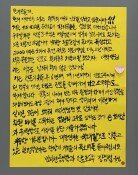Gwanghwamun
The Dong-A Ilbo carried the essay "Goodbye, Gwanghwamun" on Nov. 3, 1925. The author used the penname Goseong, meaning "lonely star." The essay described the sadness of the traditional gate for losing its place and lamented the loss of national sovereignty. You must have seen loyal vassals who passed you day and night to restore national fortunes, young rank-and-file soldiers who sacrificed themselves to defend the fortress, and patriotic martyrs who said goodbye to you shedding tears over the declining fate of the country, the essay said.
The Japanese imperial government began construction of an office building in front of Geunjeongjeon, the main building of Gyeongbok Palace. This was intended to show Japan`s power as an occupying force by overwhelming the palace, the heart of the Joseon Dynasty. Palace buildings were demolished and Gwanghwamun was torn down to be relocated. Seol Ui-shik, then Dong-A`s editor-in-chief, said in the editorial Torn Down Gwanghwamun on Aug. 11, 1926, Heavy rain falls intermittently at the old Gyeongbok Palace after a long rainy season. The sound of hammers on the roof of Gwanghwamun passes Hanyang and hits Mount Bukak. It also hits Mount Nam (Namsan). And it hits the hearts of the Korean people who lament. The editorial was one of the best written at the time.
This year marks the centennial anniversary of Japan`s annexation of Korea. The newly restored Gwanghwamun will be unveiled on Liberation Day August 15 after a hanging ceremony for the gates signboard. Gwanghwamun was built in 1395, burned down in 1592 when Japan invaded the Korean Peninsula, and restored in 1865 under the reign of King Gojong. In 1968, the gate was relocated to its original site but ended up being 10 meters away and twisted 3.75 degrees from its central axis.
The Cultural Heritage Administration will finish the restoration, which began in 2006, by the end of this month to unveil it on Liberation Day. World leaders participating in the Seoul G20 summit in November will see the splendor of the Joseon royal palace. Controversy erupted when the Japanese colonial government building, which had been used as Koreas central government building after liberation, was torn down by the Kim Young-sam administration. In retrospect, the demolition was a step in the right direction to restore the Korean people`s pride. The restored gate with its attached buildings will emerge as a Seoul landmark.
Editorial Writer Park Seong-won (swpark@donga.com)
Headline News
- Med professors announce intention to leave hospitals starting Thursday
- Bridge honoring Sgt. Moon Jae-sik unveiled in Pennsylvania
- Chief of Staff Chung tells presidential secretaries to stay away from politics
- US FTC bans noncompete agreements
- N. Korea launches cyberattacks on S. Korea's defense companies







